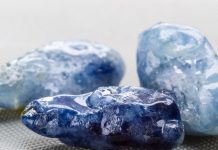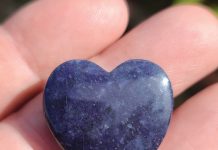
Radioactivity discoveries made before and during the Atomic Age (the period following the detonation of the first atomic weapon on July 16, 1945) were shrouded in secrecy. They changed the lives of the scientists involved, the outcome of WWII and continue to be part of our lives today. This story hits close to home, as one of those scientists was my husband John’s Uncle Grant (Philip Grant Koontz).
At an early age, John became curious about his uncle’s line of work, but his queries were often met with vague responses. As an adult, he devoted much time and effort to researching his uncle’s history.
The following is John’s perspective of that history, a few stories of the everyday life of the scientists, plus a quick rundown of naturally occurring radiation, including radioactive rocks, present in our lives today.

Philip Grant Koontz
Uncle Grant met his wife, Florence Eyre while both were undergraduate students at Hastings College in Nebraska where he earned a bachelor’s degree in 1927. He earned a master’s degree from the University of Nebraska before earning his doctorate in physics from Yale.
After graduating, Grant served as an associate professor of physics at Colorado State University. Here is where the history becomes clouded in secrecy. Sometime during Grant’s tenure at Colorado State, he met and assisted Arthur H. Compton on Mt. Evans in his studies of cosmic rays.
In 1942, Grant was asked by Compton to join Enrico Fermi and the other scientists in Chicago at the “Metallurgical Lab,” for the creation of the Chicago Pile (CP-1). Shortly after the Chicago scientists achieved a sustained nuclear reaction, Grant and his family were spirited off to Los Alamos, New Mexico. Now the secrecy was stepped up.

Photo taken by P. G. Koontz
Science, Secrecy & Real People
While both in Chicago and Los Alamos, the scientists worked feverishly on what is now called The Manhattan Project. But as history and several photos handed down through the Eyre family prove, those scientists were real people with families and interests outside of their laboratories. While still in Chicago, Uncle Grant and Aunt Florence hosted a picnic at their home. Family photos show that Enrico Fermi, his wife and young daughter, and a few unidentified scientists attended.
Once at Los Alamos, Grant took photos of several of the scientists collecting selenite in an area outside of the compound. Rockhounding must run in the family! But everyday life was hard for both the scientists and their families. All mail to friends and relatives was sent via a post office box in New York City and was carefully censored to remove any reference as to where they were, what they were doing or even anything about the weather. Grant could never tell his wife where he was going when he disappeared for days while testing bombs at Trinity Site or the Nevada Test Site.
Once some of the secrecy was lifted, Grant liked to tell a story about how he and a few of his fellow scientists discovered a hole in the Los Alamos compound fence. For fun, instead of simply telling the authorities about the security breach, a few scientists took their family dogs for a walk outside the compound. They signed out at the gate, proceeded to the hole in the fence; crawled under the fence and proceeded to sign out at the gate a second and third time before the guard caught on and they finally told him about the hole.
An Atomic Timeline
It’s time to tell the real history of these men. An easy way to do that is by using a timeline of their achievements.
The culmination of all of this work was the bombing of Hiroshima and Nagasaki in August 1945, which effectively ended WWII. Our world was forever changed and the discoveries of these scientists are still present in our day-to-day lives.

Photo taken by P. G Koontz
Rockhounding
Radioactivity didn’t just appear in our lives with these discoveries, it was always naturally occurring in our rocks and minerals. The most common radioactive minerals found in nature are uranite, thorite, pitchblende and carnotite.
One of the byproducts of atomic bomb testing is “trinitite.” Scientists gave this name to the desert sand which fused into glass caused by the heat of the first atomic bomb test on July 16, 1945, at the Trinity Test Site, outside of Alamogordo, New Mexico. Uncle Grant sent several samples to John’s dad, a chemist who cast them into paperweights made of Lucite plastic.
Radioactive Food, Medicine & Household Items
Probably the most common food containing a radioactive isotope (K-40) of potassium is bananas. Not to worry, you would need to eat 70,000 bananas to get the equivalent radiation of a chest CT scan. Small amounts are also found in potatoes, kidney beans, sunflower seeds or any food containing potassium.
On the other hand, Brazil nuts contain small amounts of radium isotopes approximately 1,000 times higher than those found in other foods. Some salt substitutes contain small amounts of radioactive potassium (K-40).
Many generic brands of antidiarrhea medication contain kaolin clay that has elevated levels of uranium and thorium.
Still, no worries, as you would have to consume over 1,000 pounds a year to exceed the current EPA maximum exposure level. The name brand of this drug has discontinued use of kaolin clay.
Ionization-type smoke detectors contain small quantities of americium-241. Never try to disassemble one of these units.
Kitty litter contains bentonite clay which is measurably radioactive. The contents include uranium, thorium and potassium-40. Also, potassium chloride water softener salt contains measurable amounts of potassium-40. A standard 50-lb. bag would never make it past the highly sensitive radiation monitors used at nuclear power plants.
Radioactive Timeline1789: M.H. Klaproth Uranium is discovered to be an element 1828: J.J. Berzelius Thorium is discovered to be an element 1896: Henri Becquerel Uranium is discovered to be radioactive 1898: Marie & Pierre Curie Radium & polonium are discovered to be elements 1911: Earnest Rutherford Confirms Becquerel’s discovery of radioactivity 1913: Niels Bohr Electrons are discovered 1919: Earnest Rutherford Protons are discovered 1932: James Chadwick Neutrons are discovered 1933:Leo Szilard Theorized and patented a method of creating an atomic bomb 1934:Enrico Fermi The first use of neutrons to create and confirm the process of fission 1939:Enrico Fermi Proposes creating an atomic pile reactor fueled by uranium metal and uranium oxide to produce a sustained nuclear reaction 1940 – 42: Enrico Fermi, Arthur Compton & Other Scientists Creation of the Chicago Stagg Field Atomic Pile, (CP-1) headed by Fermi. A sustained nuclear reaction was achieved on Dec. 2, 1942 January 1943 to July 1945: The Manhattan Project Scientists Development and testing of atomic bombs, fueled by Uranium (U-235) or Plutonium (U-239) by scientists at various locations in the U.S. |
Radioactive Collectibles

Uranium Glass
Early civilizations used minerals to add color to their glass and pottery. Uranium, or Vaseline glass as it is sometimes called, was not known to be radioactive until 1896. However, some earlier glassware contained radioactive colorants for over 2,000 years. It is usually yellow to green and is fluorescent under UV light. It contains two to 25% uranium oxide and is slightly radioactive.
Uranium glass is collectible and was made into various items from everyday glassware to bowls, knick-knacks and souvenir items. The bowl this author’s grandmother used to make gelatin in every week as well as her special occasion stemware is still a part of our family’s collection.

Orange Fiesta Tableware
Uranium oxide has been added to ceramic glazes for many years to color pieces orange-red. The Homer Laughlin Company used it to produce their bright orange Fiesta tableware from 1936 to 1943. Its use ended in 1943 when the company’s supply of uranium oxide was commandeered by the U.S. government for use in atomic weapon production. To this day, all of these original pieces are fairly radioactive and should NOT be used for food purposes, but only as radioactive collectibles.
Lantern Mantles, Metal Alloys & Welding Rods
Non-nuclear uses of thorium compounds are limited. Thorium oxide is the coating used on gas lantern mantles in older camping lanterns. It’s what causes the lanterns to incandesce at high temperatures. Several types of nickel alloys have thorium oxide added to them to increase their strength.
Thorium oxide is also used as an additive to some tungsten-based welding rods. TIG welding rods are available with a 2% thorium content to help in arc stabilization and are slightly radioactive.
3M Model C-15 Tape Dispensers
Next time you wrap a present, take note of your tape dispenser. If it is old and exceptionally heavy, it may be one of the 3M company dispensers made in the 1970s. These models were filled with monazite sand for ballast. Monazite is a radioactive mineral containing thorium.

Courtesy Oak Ridge Associated Universities
More Items
There are more radioactive collectibles than can be listed in detail, but here are just a few more:
• Firestone Brand Polonium Spark Plugs from 1946 to 1953—contain polonium
• Radium watch and clock hands—contain radium
• Glow-in-the-dark gun sights—contain tritium
• Military ballistic projectile penetrators— contain depleted uranium
• Cloisonne jewelry with orange or yellow glaze—contains uranium oxide
• Radio Brand Golf Balls 1910 to 1930— contain radium
• Gilbert Atomic Energy Lab Kit, sold in 1951-1952 as a child’s educational tool, was deemed to be dangerous and taken off the market. They are still available on the internet for upwards of $2,000 to $4,000—contain samples of autunite, carnotite, torbernite & uranite
Plan a Visit
Hands-on learning opportunities about the Manhattan Project and the Atomic Age are available with planned visits to various sites across the U.S. The National Park Service sponsors sites at Los Alamos, Hanford and Oak Ridge. You may want to visit the Bradbury Science Museum in Los Alamos. Special tours of Trinity Site and the Nevada Test Site are available on a limited basis and may require registration and possible security clearance.
Radioactivity has been and always will be present in our world. To the rockhound, if handled and stored properly, radioactive minerals and collectibles can provide an interesting addition to mineral collections.
This story about radioactivity previously appeared in Rock & Gem magazine. Click here to subscribe. Story by Sue Eyre.















